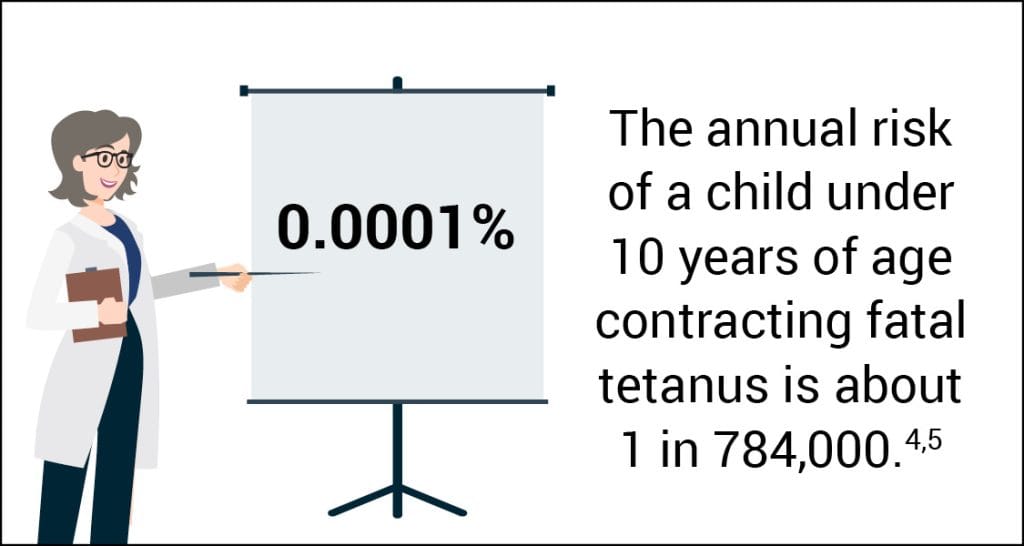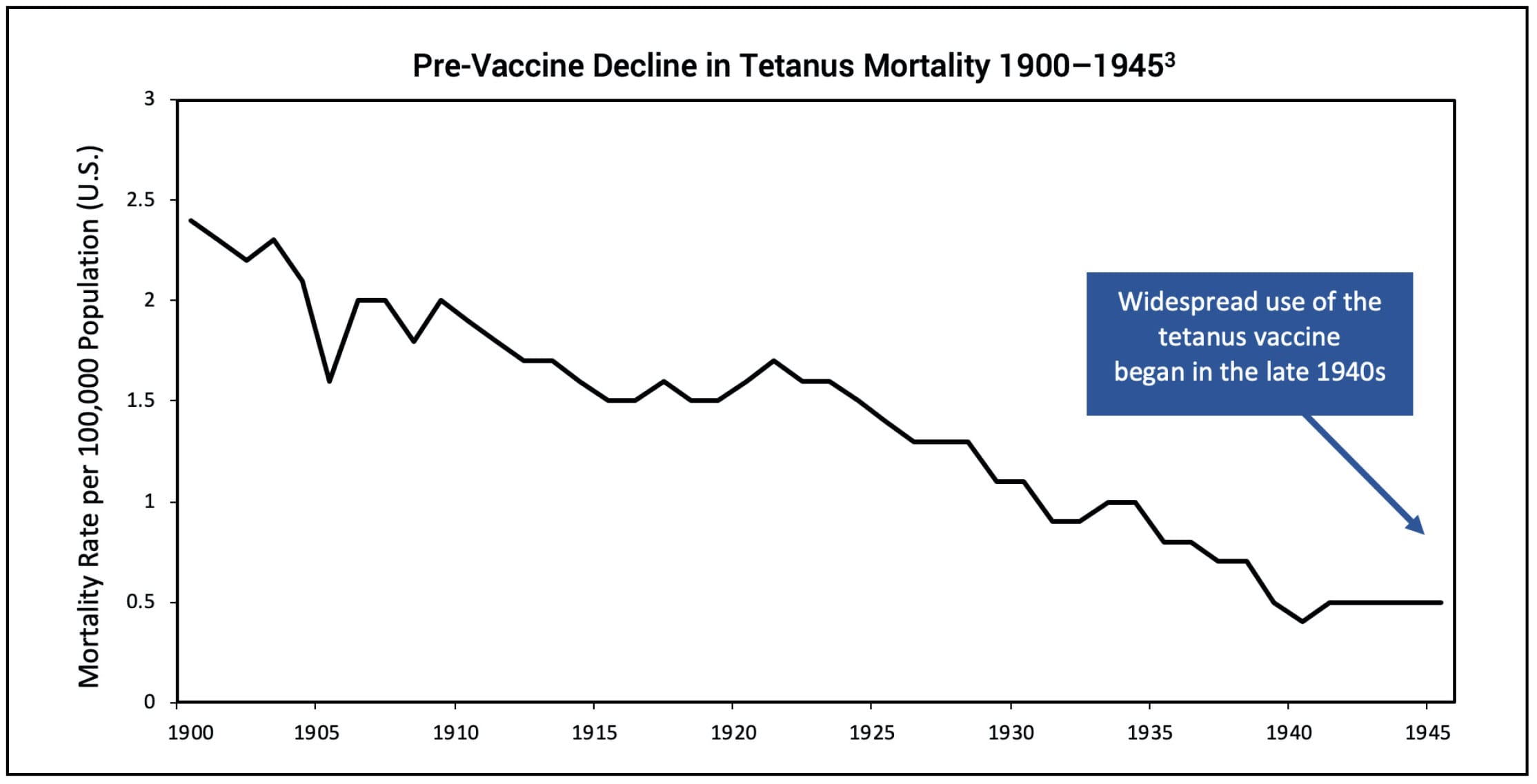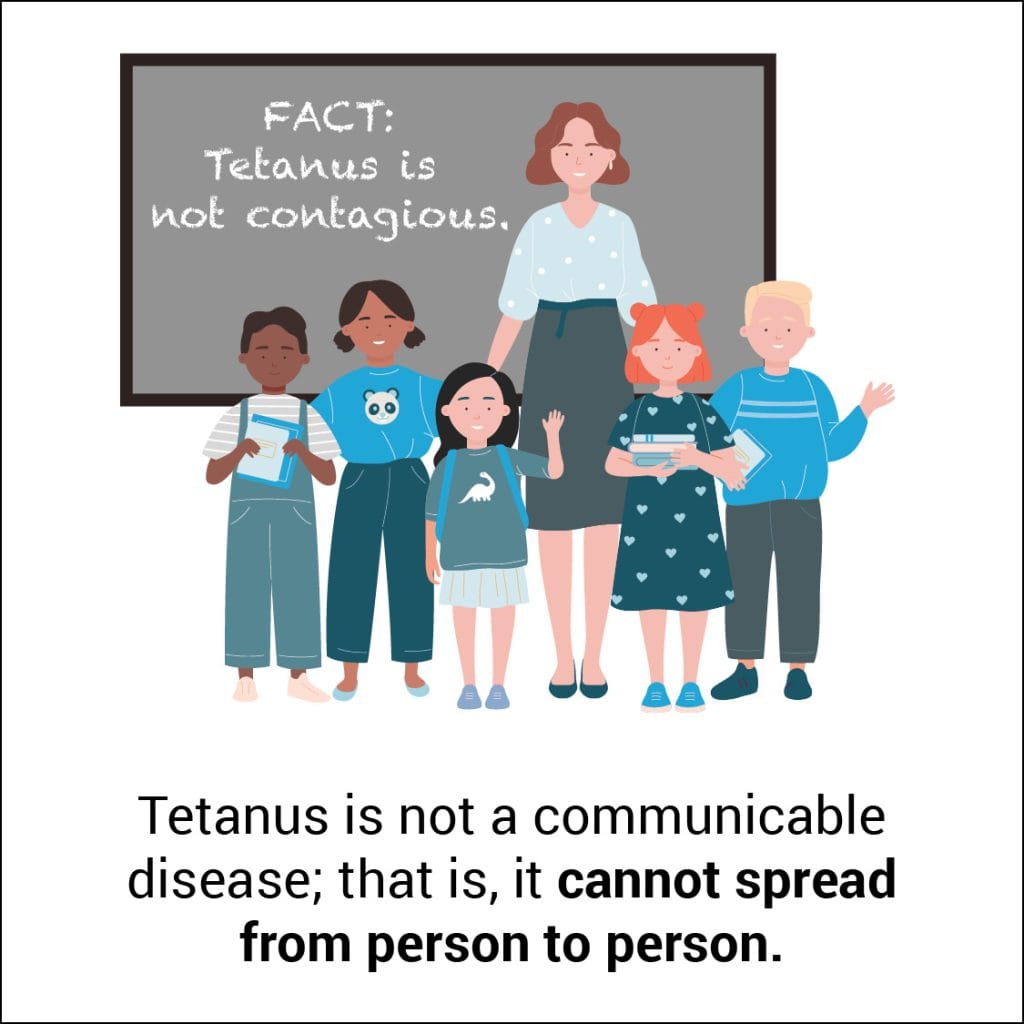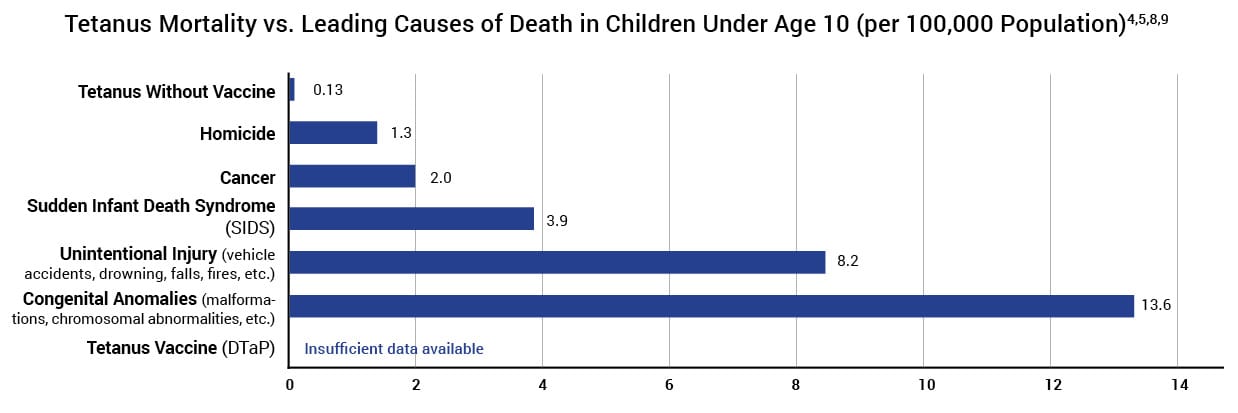Tetanus: What You Need to Know
 1. WHAT IS TETANUS?
1. WHAT IS TETANUS?
Tetanus is a bacterial infection.
- Tetanus symptoms include muscle spasms and stiffness in the jaw (lockjaw), neck, and abdomen, making it difficult to swallow or breathe.1
- In the 1940s, about 81% of tetanus cases were fatal, but due to advancements in living conditions, treatment, and health care, the percentage declined to about 6% in the modern era.2
 2. WHAT ARE THE RISKS?
2. WHAT ARE THE RISKS?
In the early 1940s, before widespread use of the tetanus vaccine began, tetanus was a disease of low incidence — the annual risk of contracting tetanus was about 1 in 180,000.2 Therefore, every year, 99.999% of the population did not contract tetanus.
In the modern era, it is rare to contract a fatal case of tetanus in the United States. Between 1900 and 1945, before widespread use of the tetanus vaccine began, the mortality rate of tetanus dropped from 2.4 per 100,000 to 0.5 per 100,000 in the population, due to advancements in living conditions, treatment, and health care — a 79% decline (Fig. 1).3
Research studies estimate that, in the absence of mass vaccination, the annual risk of a child less than 10 years of age contracting a fatal case of tetanus in the U.S. in the 21st century is about 1 in 784,000 or 0.0001%.4,5


Figure 1: The tetanus death rate declined by 79% from 1900 to 1945, before widespread use of the tetanus vaccine in the late 1940s.
3. HOW IS TETANUS TRANSMITTED?
Tetanus transmission occurs primarily through contaminated wounds. Tetanus is not contagious and cannot spread from person to person.6

4. WHAT TREATMENTS ARE AVAILABLE?
Tetanus can be prevented by cleaning the wound. It is treated by supportive therapy, maintenance of an adequate airway, and tetanus immune globulin.6

5. WHAT ABOUT THE TETANUS VACCINE?
Widespread use of the tetanus vaccine in the U.S. began in the late 1940s, and the tetanus vaccine was combined with diphtheria and pertussis vaccines as DTP in 1948. It has significantly reduced the incidence of tetanus. The manufacturer’s package insert contains information about vaccine ingredients, adverse reactions, and vaccine evaluations. For example, the tetanus vaccine “has not been evaluated for carcinogenic or mutagenic potential or impairment of fertility.”7 Furthermore, the risk of permanent injury or death from the tetanus vaccine has not been proven to be less than that of tetanus (Fig. 2).8

Figure 2: This graph shows the tetanus death rate in the absence of mass vaccination and compares it to the leading causes of death in children under age 10 today. Hence, in the absence of mass vaccination, the tetanus death rate per 100,000 is 0.13 for children under age 10. In 2015, the death rate per 100,000 for homicide was 1.3, followed by cancer (2.0), SIDS (3.9), unintentional injury (8.2), and congenital anomalies (13.6). The rate of death or permanent injury from the tetanus vaccine is unknown because the research studies available are not able to measure it with sufficient accuracy.
REFERENCES
- Centers for Disease Control and Prevention. Epidemiology and prevention of vaccine-preventable diseases. 14th ed. Hall E, Wodi AP, Hamborsky J, Morelli V, Schillie S, editors. Washington, D.C.: Public Health Foundation; 2021. 316. https://physiciansforinformedconsent.org/cdc-pink-book-14th-edition-2021/.
- Magno H, Golomb B. Measuring the benefits of mass vaccination programs in the United States. Vaccines. 2020 Sep 29;8(4):Table S4. https://pubmed.ncbi.nlm.nih.gov/33003480/.
- Grove RD; Hetzel AM; U.S. Department of Health, Education, and Welfare. Vital statistics rates in the United States 1940–1960. Washington, D.C.: U.S. Government Printing Office;1968. 559-87. https://stacks.cdc.gov/view/cdc/6200.
- Magno H, Golomb B. Measuring the benefits of mass vaccination programs in the United States. Vaccines. 2020 Sep 29;8(4):4. https://pubmed.ncbi.nlm.nih.gov/33003480/; the study reported 113 tetanus deaths occurring in the population <80 years of age. Because 45% of tetanus deaths in that age group were <10 years of age,5 there were 51 (45% of 113) deaths <10 years of age. There are about 40 million children <10 years of age in the population, therefore, the annual risk of fatal tetanus for children <10 years of age is 51 in 40 million (1 in 784,000).
- United States Public Health Service. Vital Statistics of the United States 1945 Part 1. Table 5—Deaths from each cause, by age, race, and sex: United States, 1945. Washington, D.C.: U.S. Government Printing Office;1947. 54-101. https://www.cdc.gov/nchs/data/vsus/vsus_1945_1.pdf.
- Centers for Disease Control and Prevention. Epidemiology and prevention of vaccine-preventable diseases. 13th ed. Hamborsky J, Kroger A, Wolfe S, editors. Washington, D.C.: Public Health Foundation; 2015. 343-5. https://physiciansforinformedconsent.org/cdc-pink-book-13th-edition-2015/.
- Sanofi Pasteur Limited. Toronto, Ontario, Canada: Sanofi. Daptacel (diphtheria and tetanus toxoids and acellular pertussis vaccine adsorbed); [cited 2023 Jul 31]. https://www.fda.gov/media/74035/download.
- Physicians for Informed Consent. Newport Beach (CA): Physicians for Informed Consent. DTaP (diphtheria, tetanus and pertussis) — vaccine risk statement (VRS). DTaP vaccine: is it safer than diphtheria, tetanus and pertussis? 2023 Nov. https://physiciansforinformedconsent.org/dtap-vaccine-risk-statement/.
- Centers for Disease Control and Prevention. Washington, D.C.: U.S. Department of Health and Human Services. 10 leading causes of death by age group, United States—2015. https://physiciansforinformedconsent.org/cdc-leading-causes-of-death-age-group-2015/.
Published 2023 Nov; updated 2024 Aug



